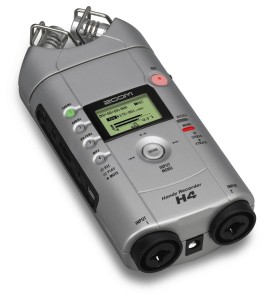ZOOM H4 HANDY RECORDER
March 13, 2007 | Reviewer: Greg Phillips
Distributor: DYNAMIC MUSIC (02) 9939 1299
 As editor of Australian Musician magazine, I get to interview a lot of performers in a myriad of locations under variable aural circumstances. Sometimes it’s via the telephone, other times face to face in a record company board room or a hotel suite. Occasionally it will be in a less ideal setting such as a noisy cafe or backstage at a gig during another band’s performance. I’ve been searching for a decent digital recorder since my trusty old dictaphone went to analogue heaven. The local distributors of Zoom products suggested I give their new H4 Handy Recorder a go, and I’m glad I did. Based on the manner in which I would use the unit in my day to day tasks as a music scribe, I barely touched the surface of the H4’s capabilities. To concern myself with choosing between a Shure SM 57 or Neumman U87 microphone simulation would just be showing off. For a working musician however, particularly one who spends a lot of time on the road, this feature packed recorder could be a god send.
As editor of Australian Musician magazine, I get to interview a lot of performers in a myriad of locations under variable aural circumstances. Sometimes it’s via the telephone, other times face to face in a record company board room or a hotel suite. Occasionally it will be in a less ideal setting such as a noisy cafe or backstage at a gig during another band’s performance. I’ve been searching for a decent digital recorder since my trusty old dictaphone went to analogue heaven. The local distributors of Zoom products suggested I give their new H4 Handy Recorder a go, and I’m glad I did. Based on the manner in which I would use the unit in my day to day tasks as a music scribe, I barely touched the surface of the H4’s capabilities. To concern myself with choosing between a Shure SM 57 or Neumman U87 microphone simulation would just be showing off. For a working musician however, particularly one who spends a lot of time on the road, this feature packed recorder could be a god send.
Let’s look at some of the H4’s most basic features. To begin with the unit offers 2 track stereo or 4 track recording modes. File types created can be either Mp3 or Wav. The built-in X/Y pattern stereo microphones offer a high standard of recording as you would expect from any Zoom product. Navigation is reasonably easy via a multi-function button on the unit’s face in conjunction with a toggle on the side. Importantly it provides XLR input and phantom power. A 1/8″ jack is provided for ear phone monitoring. It comes with microphone wind sock for blustery outdoors conditions and a tripod adaptor, for use with a stand for vibration free recordings.
Applications for the H4 could be many. The traveling musician wanting to lay down some ideas can do so easily with the option of using the many in-built effects. Using the H4 for field recording is another ideal use as is recording your rehearsals or gigs to keep tabs on how you’re sounding live.
When using the H4 in several interview situations for this edition, I found it to excel on all levels. Recording is simple .. hit the record button once and the indicator light will blink on and off letting you know you are only one more button push away from recording. Playback is just as simple.
I found the built-in microphones to have excellent stereo imaging and it’s recommended that you strategically place the H4 central to all elements involved in the recording. In one interview I conducted I was competing with the roar of a monster air conditioning unit, however by simply facing the microphones away from the howling gale, the noise was reduced to a curious hum on the recorded file. The Zoom H4 provides control over the sound levels too should you wish to fiddle with that.
Once a recording was completed, I simply plugged in the USB lead to my Mac, toggled to USB setting and the folder containing my MP3 files appeared on my computer screen immediately. All that was required then was to burn the files to a CD for the most arduous part of story preparation which is the interview transcription.
For a more realistic portrayal of the H4’s possibilities I visited ace local guitarist Marcel Yammouni to get a proper perspective on the unit. Marcel was equally impressed with the new Zoom recorder, especially the retail price of just $649. For the guitarist, the features are copious and include an array of effects taken directly from another of Zoom’s proven winners, the G2 pedal.
The effects on the unit includes the preamp module which feature characteristics of famous guitar and bass amps as well as various mic preamps. The EFX module offers chorus and other modulation effects such as delay. The input signal can also be effect processed before recording, meaning that all you need to do is hook up the unit directly to your guitar or bass, and off you go! Guitar simulators and effects can be set up as you like, from the clean sound of a Fender Twin, a Vox AC30, or Marshall 1962 Bluesbreaker to combinations such as Marshall stack with Boss SD1. Likewise bass effects include simulations of gear by names such as SVT, Hartke, Sans Amp and so on. Modulation effects like Auto Wha, Phaser, Tremolo, Chorus, Flanger and the other usual suspects are offered in addition to compressor/limiter effect types.
An integrated tuner allows chromatic tuning and also supports 7 string guitar, 5 string bass and other unconventional tunings. The metronome feature is great when doing multitrack recordings or for use during rehearsal too.
It’s highly recommended that you read the manual thoroughly. I know that’s akin to suggesting you walk on hot coals with bare feet, but in this instance the manual is in easy to follow step-by-step format, not the phone directory type tome you get with a lot of new gear.
The 128 SD memory provided is OK for ideas, but nothing substantial. If you’re looking to use it seriously, it’s recommended that you purchase a larger capacity SD card, probably around 1 gigabyte. No big whoop, you can buy them cheaply almost anywhere. Especially if you intend to record in 24 bit mode where the file sizes are much larger.
The H4 features a slick space-age design, weighs only 190g, fits into the palm of your hand and comes bundled with Cubase LE.
Battery life (two AAs) is good at 4 hours continous recording, although if you’re near a power plug, that doesn’t come into it.
We were so impressed with the Zoom H4 that we’re keeping this one. Seriously!
Thanks to Marcel Yammouni for his assistance in compiling this review


